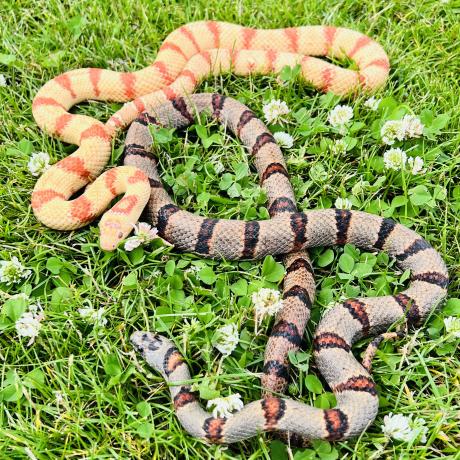

Variable Kingsnakes are classed within the beginner species of snakes and are ideal for people new to keeping reptiles or for the younger generation as their first pet snake.
| Origin | North East of Mexcio |
|---|---|
| Environment | Shrubland |
| Adult Size | 3 - 3.5ft |
| Suitability | Beginner |
| Lifespan | 15 Years + |
| Temperment | Docile |
As the name suggests, Variable Kingsnakes are just that, each one can look like a totally different species due to the colour and patterning. The typical wild type which is known as ‘Granite’ consists of a grey body with red bands, outlined in black. Another common colouration is a yellow/orange body with the same pattern. Albinos are now bred frequently and there is also the odd Melanistic which looks just like a Mexican Black Kingsnake.
They are typical-looking colubrid with a rather small head and slightly thicker body. Adults reach an adult size of 3-3.5ft making them ideal for beginners or younger hobbyists.
This species also has a few other common names which are: Theyer’s Kingsnake and Nuevo Leon Kingsnake. We think the Variable Kingsnake best suits this species due to each baby snake hatching out totally different in colour/patterning from what seem to be ‘same/normal’ looking parents.
The Variable Kingsnake can be found within semi-montane to montane habitats of limestone rocky outcrops on the Eastern mountain slopes of the Mexican Plateaus in Tamaulipas, Mexico.
An adult Variable Kingsnake should ideally be housed singularly in a minimum of a 3ft vivarium, this will allow the snake to fully stretch along the length of the enclosure. Kingsnakes name derives from their habit of feeding upon other snakes in the wild. They can be cannibalistic, even within their own species, so it is vital that they be housed alone.
The best way to provide heat would be in the form of basking or halogen bulbs protected by a guard to prevent any burns. The use of a dimming thermostat is essential to prevent any overheating in the enclosure and to give a daytime temperature gradient. During the day, the basking area should reach around 30C (86F) with the reaming parts of the enclosure between 25-27C (78-82F). Due to this species living within Montane areas, the nights do become very cool and in most households, the heat can be turned off and allowed to drop to your room temperature. The only exception to this is if you have a very cold house during the summer months, in this case, use a ceramic heater on an additional thermostat at night. Using a digital thermometer will allow you to ensure this is all set up correctly and can be moved around the enclosure to see the different gradient temperatures.
Another important piece of equipment is to provide UVB lighting, it has been proven in recent years that snakes do benefit from this when in captivity. Most snakes require a Ferguson zone 1, this is a reading of up to 1.4 on a UVI reader. Provide 12hrs of daylight during the summer months, this can be reduced to between 8-10hrs during winter.
Providing enrichment and hides is essential for your snake, this will make the snake feel secure and at times become more active in exploring its environment. The use of Aspen or Lignocel is commonly used as a substrate or you can use a natural mix of sand/soil to mimic their own habitat. Mainly active at dusk and dawn, however, you can handle the snake during any part of the day except after a meal or if in ‘blue’ (going into a shed).
Always provide fresh drinking water and change immediately if solid. The use of a dechlorinator not only removes harmful chemicals and metals but adds electrolytes which your snake will benefit from.
A young hatchling snake will initially feed on defrosted day-old pinkie mice, these should be fed every 5-7 days and the size increased as the snake grows. An adult Variable Kingsnake will take an adult mouse every 10-14 days, be aware anything too larger will be refused.
Please note: Photo is for illustrative purposes only. Kingsnakes must not be housed together due to their cannibalistic tendencies.